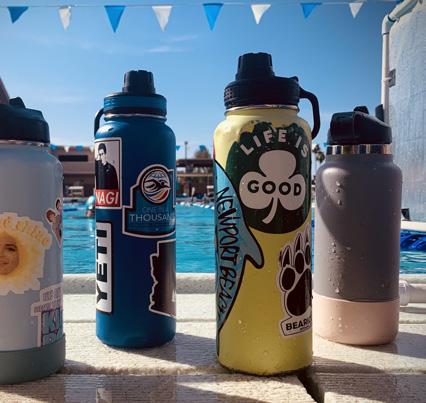
3 minute read
DRYSIDE TRAINING
HYDRATION: BEYOND THIRST!
BY DAWN WEATHERWAX, RD, CSSD, LD, ATC, CSCS
Advertisement
Hydration truly has a daily importance for all levels of swimmers, but tends to get more notoriety when the weather gets warmer.
WHY IS HYDRATION IMPORTANT? If you are 1% dehydrated, performance can decline up to 12%! Dehydration...
• Reduces speed and recovery • Decreases concentration and focus • Increases susceptibility to injuries • Accelerates fatigue • Promotes muscle breakdown • Promotes storage of fat • Decreases absorption of nutrients and removal of toxins • Enhances the possibility of muscle cramps during activity
HOW COMMON?
Two-thirds of athletes show up to practice or an event 1% dehydrated! If thirsty, they’re already 2-4% dehydrated!
HOW MUCH?
The rule of thumb is half of your weight in fluid ounces a day, NOT including activity.
Hydration during activity will vary on many factors: age, gender, body composition, intensity, duration, climate.
The quick directive is 4-16 ounces of fluid per hour of activity, but some need more, pending on the rate they sweat.
The goal is to weigh before and after activity—and weigh the same. Adjust your intake for the next activity based on outcome. The body can only absorb so much fluid at one time, which means some of you sweat more than you can take in. Remember: one pound of sweat is equivalent to 16 ounces of fluid.
OVERDRINKING?
NEVER weigh MORE than 1-2 pounds from starting weight because you can drink too much fluid. For every pound of sweat lost, you want to drink 24 ounces of fluid afterward. You don’t have to drink it all at once; in fact, you can spread it over the rest of the day.
SODIUM VS. POTASSIUM
Many people would have you believe that potassium is the main electrolyte for optimal hydration, but they are wrong. Sodium is the electrolyte that is essential. Sodium helps bring the fluid into the muscle cell versus getting urinated out by the kidneys. Athletes can lose from 200 mg up to 2,000 mg of sodium per pound of sweat versus about 30 to 150 mg of potassium per pound.
However, please do not exceed more than 400 mg of sodium an hour per activity on your own. Too much intake can be harmful as well.
From a daily dietary standpoint, athletes should aim for a minimum of 2,300 to 2,700 mg of sodium a day from food. Log on an app such as Cronometer to figure your current intake. WHAT COUNTS? • Water • Infused water • Unsweetened iced and hot teas • Milks • Nut milks • Oat milk • Premade shakes and smoothies • Juice (but in limited amounts) • Sports drinks (preferred only around activity) • Fluids you add to recipes (e.g., cereals, smoothies)
HOW TO KNOW?
Quick method: urine color. You want it to be a very light yellow color—like lemonade. If it is dark like apple juice, it means you are very dehydrated. Please note there are some flaws to this method, but it’s a good place to start. If you want to get more scientific about your hydration and electrolyte numbers, please reach out to a sports dietitian or an exercise physiologist to customize your hydration plan.
SUMMARY As you embark on your athletic goals, what you eat and drink DOES matter. Set up weekly goals and design a food and hydration schedule to maximize compliance. * * *
Here is a 3,000-3,500-calorie menu focusing on nutrition, hydration and electrolytes with a Japanese lunch flare to honor the Olympics. As always, this is an example...and not a solution for all.
3,000 to 3,500-CALORIE TRAINING MENU
Pre-Training (4:30-5:15 a.m.)
1 pkt Kodiak or Kashi oatmeal 2 T Chia seeds ½ cup Unsweetened applesauce or pureed peaches 16 oz Water (might add one Nuun tablet or Precision Hydration H2Pro electrolyte tablet)
Training (5:30-6:45 a.m.)
4-16 oz Water an hour (amount needed depends on sweat rate) (Might add one Nuun tablet or Precision Hydration H2Pro electrolyte tablet per 16 oz)







